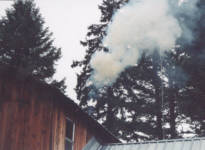

Background
Planning and logistics for the election occurred over the past 3 years,
and in 1998 the Catholic Church was ready and eager for the election.
The Conclave to elect the pope was conducted with voting coming from worldwide
electors of the Remnant Catholic Church. As there were no Cardinals alive
at the start of the Conclave, Natural Law allows for Catholics, clergy
and laymen, to be the electorate to vote for the pope. This
is because the Church as a perfect society must have the means to restore
it visible head, the pope.
The Conclave Committee, a group of 3 Catholic laymen, with the approval of the electorate, organized the logistics for the Conclave. One of the main pre-requisites for conducting a valid election was to verify that the electorate was indeed Catholic. (Note that the reason why prior attempts failed was precisely because the electors were in some way non-Catholic.) Accordingly, each elector signed 2 documents attesting to his/her Catholic standing. These documents included such items as baptism, age, beliefs with respect to Vatican II, affirming non-association with any Vatican II (Novus Ordo) individual(s), and other such items which would prove or dis-prove the elector's Catholicity.
The Conclave
On the evening before the start of the Conclave, the Conclave Committee took an oath of secrecy in front of the Blessed Sacrament, pledging to Almighty God that they would never reveal any of the proceedings or votes that transpired within the Conclave.The Conclave Committee, with all the plans in place, did gather in a central place to administer the voting. Conclave voting began on October 23, 1998 at 1:00 PM, US Mountain Time. Each ballot, according to plans, would be of 24 hours duration.
Since the electorate, being a worldwide body, without the financial means or resources to gather in the central place for the Conclave, cast ballots using today�s God-given technology of the telephone. Security of voting was ensured using secret and unique voting codes assigned to each elector to authenticate each vote. The Conclave Committee triple-checked each vote as it arrived as well as each other to ensure the accuracy and integrity of the proceedings.
White Smoke
When the 24 hours had elapsed for Ballot 1, a tally was taken of the votes. The tally was triple-checked again by the committee for accuracy. A vote of 2/3 (plus 1) was needed to elect. The Dean of the Committee according to pre-arranged procedures, contacted the elect to ask if he accepted the papacy. When Fr. Pulvermacher accepted, at that very moment, the papacy was restored. The Dean also asked by what name he wished to be called. Fr. Pulvermacher indicated the name of Pius XIII, and that his choice of name would proclaim to the world that the last true pope was his predecessor, Pius XII.White smoke from the burning of ballots at the Vatican was the traditional way of informing the world that a pope has been elected. The excitement and anticipation of seeing the new pope emerge is always a great joy for Catholics. As this election was conducted in a way much different from the traditional method, the College of Electors was notified via telephone that �Habemus Papam!� or �We have a pope!� This was followed by announcing to the world via any and every means available, including Newspapers, TV and Radio Stations, Internet, and Short Wave Radio.
 To
follow in the spirit of conclaves past, however, the ballots were burned
in a wood stove and white smoke ascended to the mountains of Montana.
The image to the right is the actual white smoke of the Conclave of 1998.
Instead of hundreds of thousands of cheering faithful in Vatican square,
the white smoke was seen only by a handful of the faithful, as well as
by God's creatures of the forest.
To
follow in the spirit of conclaves past, however, the ballots were burned
in a wood stove and white smoke ascended to the mountains of Montana.
The image to the right is the actual white smoke of the Conclave of 1998.
Instead of hundreds of thousands of cheering faithful in Vatican square,
the white smoke was seen only by a handful of the faithful, as well as
by God's creatures of the forest.
Top of Page |
 Pope's
Homepage Pope's
Homepage |
|
 |